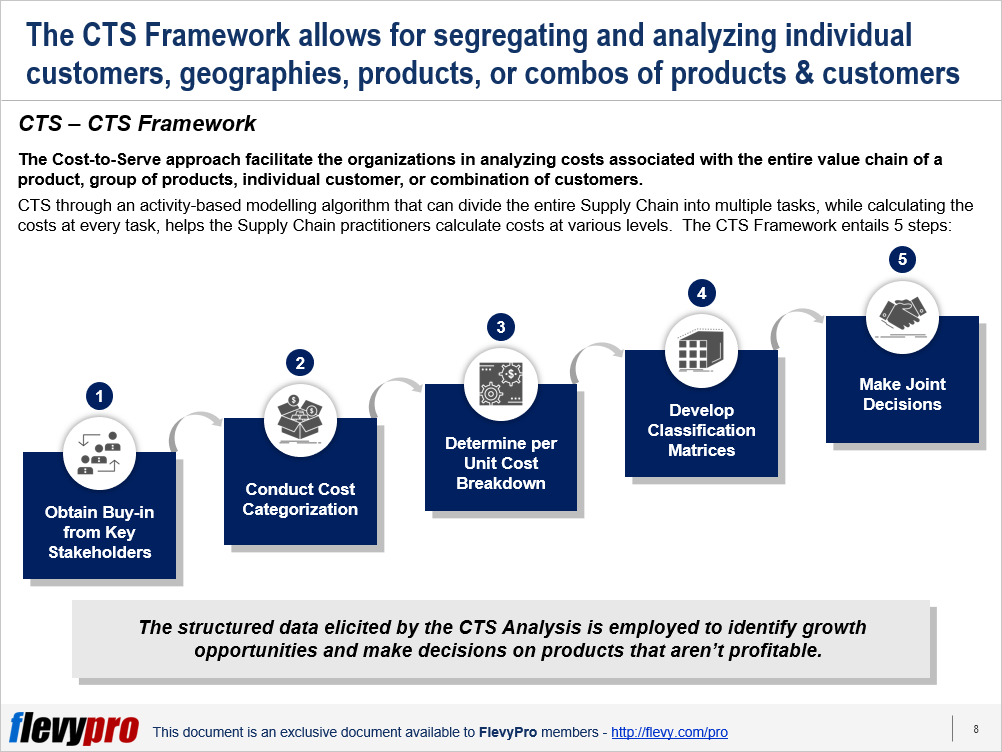Supply chain management across industries is being revolutionized at a rapid pace by technology. By implementing technology systems, supply chain organizations aspire to eliminate waste, meet customers’ needs at reasonable costs, and ensure profitability. Enterprise Resource Planning systems facilitate in processing unstructured data at an aggregated level. However, at workflow or micro level the data produced through ERPs needs to be further refined to understand costs.
Supply chain experts need to look at their unstructured data and understand the cost of offering a product; know which product mix they should promote; and gauge the impact of service levels on transportation costs, profits, and pricing strategy.
Supply Chain Executives can use the Cost-to-Serve (CTS) Analysis approach to control distribution costs, identify negative-margin products, and prevent profit leakages. CTS Analysis affords the organizations the means to identify the total cost of serving customers—including all the costs in a product’s value chain (from raw material to delivery)—at the product as well as customer levels. The approach helps leaders split and evaluate individual customers, geographies, products, product families, or combinations of products / customers.
The Cost-to-Serve Analysis can be undertaken to identify costs related to Supply Chains, Logistics, Distribution, Warehousing, or Transportation. CTSA allocates indirect cost to products—overhead or fixed costs that are not easily and directly attributable to a single order, shipment, or activity.
The CTS model for costing entails detailed modeling of all the value and non-value added activities in the process. The approach is more precise than other methods in determining “what-if” budgets, as it accounts for all the activities and link them with their relevant cost pools. CTS employs an activity-based modelling algorithm—which segregates the entire supply chain into multiple tasks while calculating the costs at every task—to help the supply chain practitioners calculate costs at various levels.
The CTS Framework entails 5 fundamental steps:
- Obtain Buy-in from Key Stakeholders
- Conduct Cost Categorization
- Determine per Unit Cost Breakdown
- Develop Classification Matrices
- Make Joint Decisions
Let’s delve deeper into the first 2 steps of the CTS Framework.
1. Obtain Buy-in from Key Stakeholders
The first step to implement Cost-to-Serve Framework involves getting across-the-board agreement and stakeholder buy-in. The decision to calculate the impact of cost to serve on revenue entails engagement and collaboration from multiple departments in a company. Multiple cost centers work in partnership across a value chain and thus profit and loss responsibility cannot be attached to a specific unit.
For instance, a decision to trim down the costs to serve a customer (or various customers) has to be agreed upon by stakeholders from the:
- Sales and marketing department to calculate the impact of service level agreements.
- Logistics function to calculate the cost impact.
- Go-to-market Strategy to ensure alignment with Corporate Strategy
- Warehousing unit to ensure resource planning and allocation.
2. Conduct Cost Categorization
The 2nd step of the Cost-to-Serve Framework involves categorization of costs associated with the entire supply chain. Supply chains typically have various cost centers (or functions): e.g., Procurement, Manufacturing, Warehousing, and Logistics. These cost centers further have multiple processes with costs associated with all of them. CTS requires top-down estimation of costs at the process and activity level and then aggregate those back to the cost center level.
This categorization of costs across the various functions of the supply chain and their associated processes facilitates in accurate calculation and obtaining estimates at the micro level.
Interested in learning more about the other steps of the Cost-to-Serve Framework? You can download an editable PowerPoint presentation on Cost-to-Serve Analysis here on the Flevy documents marketplace.
Are you a Management Consultant?
You can download this and hundreds of other consulting frameworks and consulting training guides from the FlevyPro library.

Comments